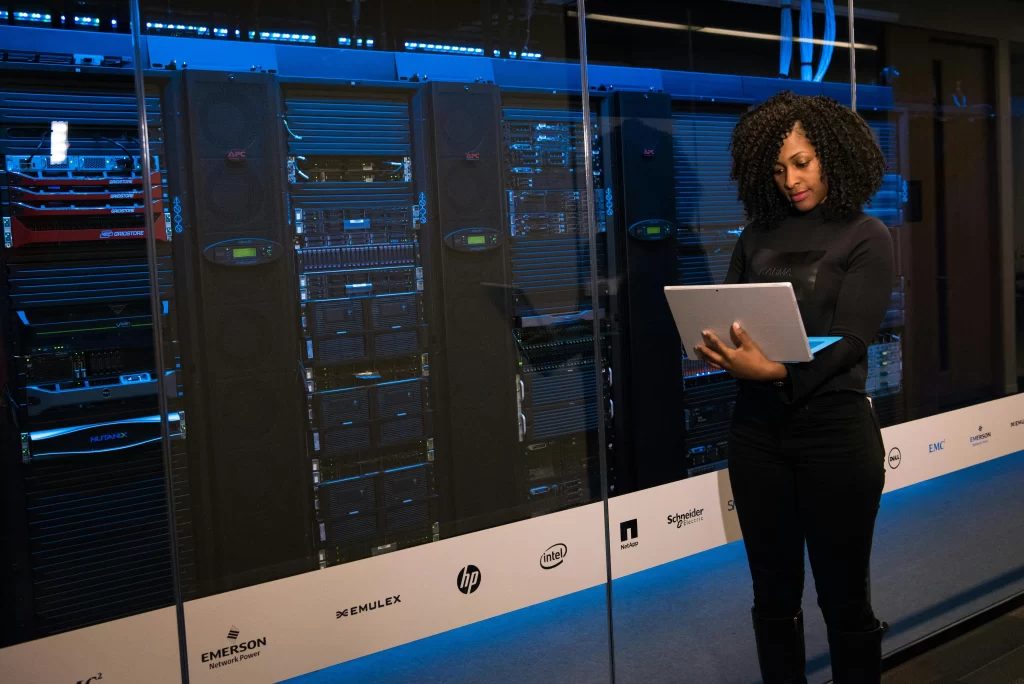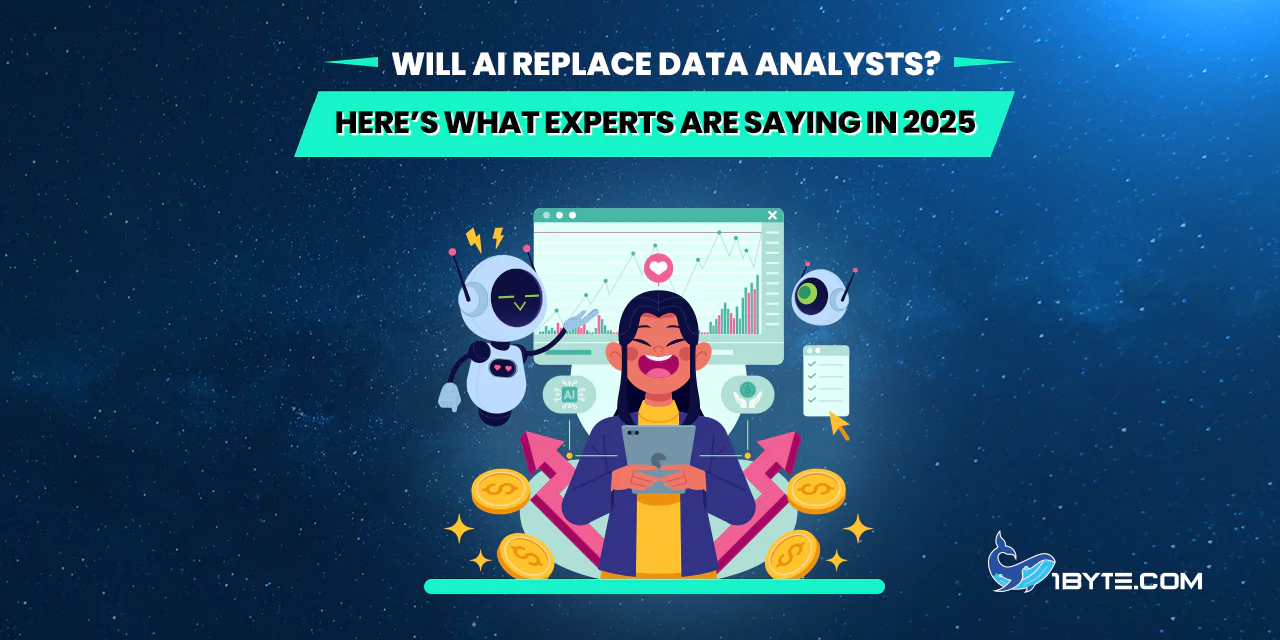Will AI replace data analysts? This burning question is on the minds of professionals worldwide as artificial intelligence rapidly advances. In 2025, tools like GPT-4 and AI-driven analytics platforms are performing tasks once reserved for humans, from generating charts to interpreting trends. The idea of AI taking over data analysis sparks both excitement and anxiety. This article delves into what the experts and latest data say about the fate of data analysts in the age of AI. We’ll explore up-to-date statistics, real-world examples of AI automation, and a global perspective on how data analysis roles are evolving. The verdict may surprise you – rather than making data analysts obsolete, AI appears to be transforming and elevating the role. Short, simple sentences and a logical flow will make these insights easy to follow. Let’s dive into this article from 1Byte.
AI’s Growing Role in Data Analysis
Artificial intelligence is now embedded in many data analysis processes. Organizations worldwide are leveraging AI to handle larger datasets, speed up workflows, and automate routine tasks. In a new global survey of 1,400 data analysts, 97% said AI tools accelerate their daily tasks. This means that nearly all analysts surveyed acknowledge AI as a boost to their productivity. For example, AI-driven software can automatically collect data from multiple sources, clean and organize it, and even perform initial analyses in a fraction of the time a human would take. Mundane chores like data cleaning or basic reporting, which used to consume hours of an analyst’s day, can now be done by AI in minutes.
FURTHER READING: |
| 1. AI in Social Media: 10 Tools to Boost Your Brand in 2025 |
| 2. AI in Supply Chain: What Decision-Makers Need to Know for 2025 |
| 3. AI in Customer Service: Things You Need to Know |
Data preparation and cleaning

Modern AI tools use machine learning to detect errors or outliers in data, fill missing values, and format datasets for analysis. This reduces the manual spreadsheet drudgery analysts traditionally faced. (Notably, 76% of analysts still admit to relying on manual spreadsheets for some tasks, showing that while AI is helpful, it hasn’t entirely eliminated older methods yet.)
Code generation and queries
Today’s generative AI can write code on the fly based on natural language prompts. Analysts can ask an AI assistant to generate an SQL query or a Python script to analyze data. AI coding assistants like GitHub Copilot and ChatGPT’s code generation feature can produce working code snippets in seconds, automating many tedious programming tasks that analysts used to do line by line.
Automated insights and summaries
AI algorithms can sift through mountains of data to find patterns and then summarize key insights in plain language. Some business intelligence (BI) tools now come with AI-powered “insight generation”. For example, a system might analyze sales data and automatically highlight that “Region X had a 20% higher growth than other regions due to a spike in product Y sales.” These instant insights help analysts focus on interpretation rather than discovery from scratch.
Real-world examples abound of AI handling data analysis tasks. In the retail sector, Majid Al Futtaim (a major Middle Eastern retail conglomerate) integrated advanced AI for customer feedback analysis and automated reporting. The result? The company saved $1 million annually and cut a feedback analysis process from 7 days to just 3 hours. This dramatic improvement shows AI’s power to accelerate analysis. In telematics, Geotab (a global vehicle tracking company) uses Google’s AI tools to analyze billions of data points from 4.6 million vehicles daily – a scale of analysis that would be impossible without AI. These examples illustrate that AI isn’t science fiction; it’s already crunching numbers and finding needles in data haystacks in the real world.
Despite these impressive capabilities, it’s important to note that AI’s role is largely assistive. As analytics automation rises, data analysts find themselves working alongside “digital colleagues” that handle grunt work. One popular saying captures it well: “AI won’t replace data analysts, but analysts who use AI will replace those who don’t.” In other words, leveraging AI is becoming part of the job description. A Harvard Business School expert put it succinctly: “AI is not going to replace humans, but humans with AI will replace humans without AI.” Embracing AI tools is now essential for analysts to stay efficient and competitive.
AI’s Capabilities vs. Human Insight: Key Differences
A data analyst reviews AI-generated code and insights on a tablet. Advanced AI can generate code and preliminary analysis, but human experts add crucial context and domain knowledge.
With AI handling more data and routine analysis, some wonder if human analysts will become redundant. However, experts emphasize that AI cannot (at least not yet) replicate human insight, critical thinking, and contextual understanding. Generative AI and machine learning excel at pattern recognition and speed, but they have notable limitations that prevent them from fully replacing human analysts:
Lack of contextual understanding
AI can crunch numbers but doesn’t truly understand what those numbers mean in a broader business or social context. As veteran analyst Donald Farmer explains, “AI can process large data sets and provide quantitative analysis. It can’t understand the subtleties of human behavior the way human analysts can.” Data isn’t just numbers; it represents real human customers, operations, or phenomena. A human analyst can connect data to real-world context, seeing the story behind the numbers. For instance, an AI might flag a correlation between ice cream sales and city traffic accidents and suggest a relationship. A human knows a heatwave is causing both, an insight from common sense that AI lacks.
No empathy or domain intuition

Much of data analysis involves asking the right questions and interpreting results in light of human factors (like customer motivations or market trends). AI doesn’t have empathy or intuition. Farmer notes that successful analysis often requires understanding “motivations, fears, ambitions” of people involved – something “artificial intelligence currently lacks”. An AI might identify what is happening, but a person is better at probing why it’s happening.
Limited creativity and critical thinking
AI algorithms operate on training data and predefined logic. They struggle with thinking outside the box or questioning the data itself. Human analysts excel at formulating new hypotheses, spotting anomalies that don’t fit an expected pattern, and challenging the quality of the data. Generative AI models do not know to question the validity or bias in their source material. A human analyst will notice if the data seems off or if an analysis result doesn’t pass a common-sense check, whereas an AI might blissfully output a flawed insight if it was trained that way.
Issues with accuracy and trust
AI can make mistakes – sometimes bizarre ones. Without human oversight, AI-generated analyses can contain logical gaps or outright errors. This is known as the problem of “AI hallucinations” in generative models. The model might create a very convincing narrative or chart that is actually incorrect or based on faulty reasoning. For example, an AI might generate a beautiful graph but label axes incorrectly or draw conclusions from spurious correlations. Human review is needed to verify AI outputs. In high-stakes analysis (like financial reporting or medical data analysis), an unchecked AI error could be costly. Thus, companies pair analysts with AI, using the AI for draft analysis and the human for validation.
Difficulty with changing data and new situations
AI models require training on historical data. If the world changes (say, a sudden market shock or a pandemic altering consumer behavior), the AI might not immediately adapt because it’s anchored in past patterns. Retraining AI models is possible but not instantaneous. A human analyst, on the other hand, can incorporate the latest events and qualitative information on the fly. Experts point out that an AI model could be “several months behind on data” if not frequently retrained, leading to a “significant knowledge gap” in fast-changing environments.
Because of these limitations, generative AI and analytics automation are seen as tools to augment analysts, not replace them. Farmer concludes plainly that “Generative AI will not replace data analyst jobs” and that it is “not a substitute for human analysts” but rather an asset with human oversight. The International Institute of Business Analysis (IIBA) likewise emphasizes that AI is “not intended to replace human data analysts” but to relieve them of tedious tasks so they can focus on more strategic work. In practice, this means AI might generate the first draft of a report or find initial patterns, and then the analyst refines the analysis, checks for correctness, and turns it into actionable recommendations.
Experts on Whether AI Will Replace Data Analysts
So, will AI replace data analysts? The consensus among experts in 2025 is a resounding “No” – at least not in the foreseeable future. Leaders in technology, analytics, and business analysis are seeing AI as a powerful assistant rather than a replacement for the human analyst. Here’s a rundown of what experts and industry voices are saying:
Industry analysts and thought leaders
Donald Farmer, a seasoned analytics expert, states that while AI can automate aspects of data work, it “lacks human insights and knowledge to do the job” fully. In his view, human analysts provide nuance that AI cannot. Another common industry viewpoint is captured in the Harvard Business Review: “AI won’t replace humans — but humans with AI will replace humans without AI.” In other words, analysts who embrace AI will outcompete those who do not, but the human element remains indispensable.
Business and tech executives
Many corporate leaders acknowledge AI’s power but do not see it as a one-to-one replacement for analysts. For instance, Satya Nadella (CEO of Microsoft) often describes AI as a tool to empower employees. The prevailing strategy in companies is to reskill analysts to use AI, not to fire and replace them. In fact, 83% of companies believe employees can secure their positions by learning AI skills and staying valuable. Forward-thinking businesses encourage their data teams to incorporate AI for greater productivity rather than view AI as a threat.
Academic and professional organizations
The International Institute of Business Analysis (IIBA) has directly addressed job fears, reassuring that AI provides assistance, not a pink slip. IIBA notes that in the “age of AI, data analysts will shift from manual work to more strategic tasks” – things like making data-driven decisions, communicating insights to stakeholders, and ensuring ethical data use. Those higher-level responsibilities are even more in demand as AI handles the grunt work. Similarly, educators in data science programs emphasize that the role is evolving, not vanishing. Champlain College, for example, published an analysis in late 2024 concluding, “Will AI replace data analysts? Fortunately, the answer is no.” They found that data analysts are still in high demand, with AI used to assist rather than replace them.
Sector-specific insights
In specialized fields like healthcare and clinical research, experts note that AI isn’t ready to work solo. A Clinical Leader article addressing analysts in clinical trials concluded it’s “unlikely that AI will completely replace data analysts… anytime soon”, citing reasons such as the need for human judgment in complex, regulated analyses. Even in finance, where AI models are extremely advanced, human analysts are needed to interpret unexpected market events and to meet regulatory requirements for oversight.
The expert consensus highlights an important nuance: AI is changing the skills profile of data analysts rather than eliminating the role. Instead of spending time on manual data extraction or simple trend reporting, analysts are increasingly expected to become “AI-savvy” – using AI tools to work faster and focusing on strategic analysis. Champlain College’s report underscores that aspiring analysts should “become proficient in the latest AI technology” to set themselves apart. Those who upskill can harness AI to amplify their impact.
In sum, the voices of 2025 say that AI will not outright replace data analysts. It will, however, replace some of the tasks they used to do, requiring analysts to adapt. The role is shifting toward a partnership between human and AI: the AI does the heavy lifting with data, and the human adds experience, interpretation, and decision-making. Data analysts who ride this wave are actually more valuable than before – 87% of analysts in one survey feel more strategically important in their organization than a year ago thanks to AI tools augmenting their work.
Current Job Market Trends and Statistics
From a job market perspective, data analysts are not disappearing – quite the opposite. Demand for data analysts continues to grow in the AI era, according to labor statistics and global reports. Here are some key trends and numbers painting the picture as of 2025:
Strong job growth projections

The U.S. Bureau of Labor Statistics projects a 23% increase in employment of data analysts (and related roles) by 2032, much faster than the average for all occupations. Globally, the outlook is similar. The World Economic Forum’s Future of Jobs Report 2023 ranked “Data Analysts and Scientists” among the top fastest-growing jobs worldwide. These roles are projected to grow by 30-35% by 2027. In fact, data analysts/scientists are listed in the top 10 growing jobs, alongside AI specialists themselves. Growth is driven by virtually every industry becoming more data-driven, from finance to retail to healthcare.
Continued high demand despite automation
If AI were simply replacing analysts, we’d expect to see job postings decline – but that’s not happening. A 2025 job market analysis found companies are still “desperate for professionals who can turn numbers into insights.” Many roles are shifting to require a combination of analysis and AI tool expertise, rather than being eliminated. The global big data analytics market is booming, expected to grow from $23 billion in 2019 to $133 billion by 2026. This massive market expansion indicates companies are investing in analytics (often alongside AI), which correlates with hiring talent to leverage those tools.
Low job insecurity among analysts
Interestingly, most data analysts themselves are not very worried about losing their jobs to AI. Only 17% of data analysts expressed deep concern that AI will take over their job. That means roughly 83% are not deeply concerned – likely because they see that their roles are evolving rather than vanishing. Analysts often report that AI is automating parts of their work, but also expanding the scope and impact of their role. For instance, with AI handling data prep, an analyst can now focus on deeper analysis and take on more projects simultaneously, making them even more indispensable to their employer.
Job churn vs job creation
It’s true that AI will displace some jobs by automating tasks, but it will also create new ones. The WEF estimates 83 million jobs may be lost due to AI automation by 2027, but 69 million new jobs will be created in the same timeframe. Data analysts, notably, fall on the creation side of that equation – they are among the jobs created or enhanced by AI trends, not destroyed by them. For example, while “data entry clerks” (a more routine job) are projected to see decline, data analysts (who interpret data) are in the growth camp. This aligns with the idea that AI handles the lower-skill data tasks, increasing the need for higher-skill analyst roles.
Companies expect AI to augment workforce
In surveys of employers, a majority expect AI to be net-positive for jobs in their organization. 50% of companies foresee AI-driven job growth, versus 25% that anticipate job losses as a result of AI integration. Many companies are actively retraining their workforce; about 42% of employers plan to train workers in AI and big data skills by 2027. This shows businesses intend to keep people and have them work with AI, rather than let AI replace those people. Notably, IBM’s CEO made headlines in 2023 for pausing some hiring in back-office roles due to AI, but those were largely for highly repetitive roles like certain HR positions. In contrast, hiring for data and AI talent remains robust.
From these trends, the global perspective is clear: data analysis as a profession is not only surviving the AI revolution, it’s one of the careers thriving because of it. The world needs more data-literate professionals to harness the flood of information and the sophisticated AI tools available. The World Economic Forum specifically highlighted that analytical roles (data analysts, scientists, BI analysts) will be especially in demand in industries like supply chain, consumer goods retail, and financial services as they undergo digital transformation. This demand is worldwide – companies in North America, Europe, and Asia alike are hunting for talent that can marry domain knowledge with analytical and AI skills.
Leverage 1Byte’s strong cloud computing expertise to boost your business in a big way
1Byte provides complete domain registration services that include dedicated support staff, educated customer care, reasonable costs, as well as a domain price search tool.
Elevate your online security with 1Byte's SSL Service. Unparalleled protection, seamless integration, and peace of mind for your digital journey.
No matter the cloud server package you pick, you can rely on 1Byte for dependability, privacy, security, and a stress-free experience that is essential for successful businesses.
Choosing us as your shared hosting provider allows you to get excellent value for your money while enjoying the same level of quality and functionality as more expensive options.
Through highly flexible programs, 1Byte's cutting-edge cloud hosting gives great solutions to small and medium-sized businesses faster, more securely, and at reduced costs.
Stay ahead of the competition with 1Byte's innovative WordPress hosting services. Our feature-rich plans and unmatched reliability ensure your website stands out and delivers an unforgettable user experience.
As an official AWS Partner, one of our primary responsibilities is to assist businesses in modernizing their operations and make the most of their journeys to the cloud with AWS.
Conclusion
After examining expert opinions, industry trends, and global data, we can answer the question “will AI replace data analysts?” with a high degree of confidence: No – AI will not replace data analysts, but it will change what their job looks like in 2025 and beyond. The relationship between AI and data analysts is one of collaboration. AI is superb at handling the heavy lifting of data processing and even at generating initial insights. Yet, it lacks the human qualities needed to drive analysis to its full impact – understanding context, exercising judgment, and communicating meaning.
Experts in 2025 overwhelmingly view AI as a tool that augments the data analyst’s role. Surveys show analysts feel more empowered and valuable with AI in their toolkit, not sidelined by it. Companies are continuing to hire and develop data analysts, expecting them to leverage AI for greater productivity. Real-world examples across the globe demonstrate that when AI and analysts work together, organizations get the best results – faster analyses, deeper insights, and well-informed decisions.That said, the onus is on data analysts to evolve with the technology. The profile of the “data analyst” is shifting toward a tech-savvy, business-minded professional who can use AI, not someone who only knows traditional manual methods. The future of this career is bright for those who embrace continuous learning. As one report succinctly put it, the data analyst role isn’t going anywhere but up. The key is to “stay flexible, embrace new technologies, and master the in-demand skills” needed in an AI-driven environment.

